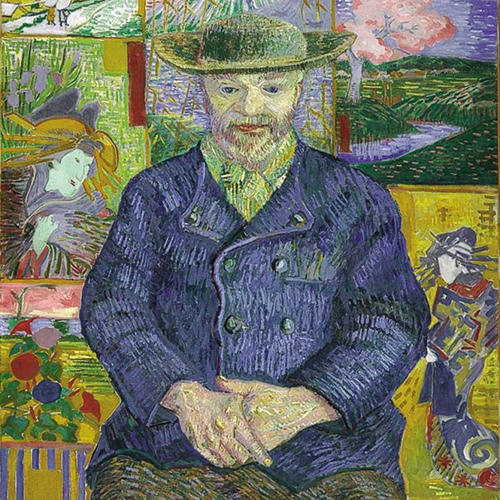
Portrait of Père Tanguy by Vincent van Gogh, 1887 (Rodin Museum)
Vincent van Gogh spent 1886 to 1888 in Paris, living with his brother Theo, an art dealer. Theo’s connections with the avant-garde art world gave van Gogh a quick and intensive contemporary art education as he was drawn into a social and artistic circle of like-minded painters that included Pissarro, Seurat, Signac, Gauguin, Laval, Bernard, Anquetin, and Toulouse-Lautrec. He called the rising group the Painters of the Petit Boulevard to distinguish them from the established and successful Impressionists like Monet, Degas, and Renoir.
Van Gogh’s time among these young artists was among the most influential in his brief life. In searching for his own style, he rapidly passed through approaches including Impressionism and Divisionism, lightening his Dutch-inspired palette, and breaking up his brushstrokes. He conceived the idea of his fellow artists joining him in a community he called the Studio of the South—a colony that never came to pass.
Art historian Bonita Billman explores the Parisian lives and careers of the Painters of the Petit Boulevard and their depictions of the celebrities and scenes of everyday Montmartre—the night life and low life of a bohemian world.
10–11:15 a.m. The Avant-Garde Art World of Paris
In 1886, the Impressionists held their final group exhibition, showcasing a style of painting we now call Post-Impressionism and reflecting new directions that artists like Gauguin, Seurat, Signac, and van Gogh were taking in their work. By that time, Monet, Degas, and Renoir had found some financial success, whereas Pissarro and Sisley hadn’t achieved as much. Pissarro continued to experiment under the influence of the younger painters around him, feeling they had much to teach him.
11:30 a.m.–12:45 p.m. Vincent in Paris, 1886–1888
Despite his brother’s knowledge of the avant-garde art world, van Gogh did not really understand Impressionism until he arrived to live with Theo. He then underwent a rapid artistic evolution under the influence of his friends and colleagues in Paris, particularly Camille Pissarro.
12:45–1:15 p.m. Break
1:15–2:30 p.m. Divisionists and Symbolists
An examination of the art of the Post-Impressionists, with a focus on Seurat’s and Signac’s Divisionism and Symbolism in the work of Paul Gauguin and Emile Bernard.
2:45–4 p.m. Moulin Rouge: Toulouse-Lautrec and Colleagues
With no interest in art colonies or in leaving Paris (unlike Gauguin, van Gogh, and others), Henri de Toulouse-Lautrec preferred the haunts and habitués of Montmartre. The brothels and cabarets, prostitutes and performers were his genre scenes of everyday life. His paintings and posters of a bohemian world symbolize the Belle Epoque for us today.
World Art History Certificate elective: Earn 1 credit*
General Information
*Enrolled participants in the World Art History Certificate Program receive 1 elective credit. Not yet enrolled? Learn about the program, its benefits, and how to register here.